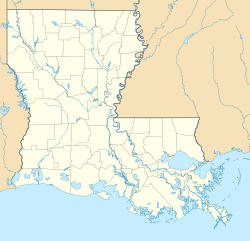Fullerton, Louisiana facts for kids
Quick facts for kids |
|
|
Fullerton Mill and Town
|
|
| Location | Louisiana Highway 399 |
|---|---|
| Area | 175.2 acres (0.709 km2) |
| NRHP reference No. | 86003353 |
| Added to NRHP | October 24, 1986 |
Fullerton is a small, unincorporated community in Vernon Parish, Louisiana. It was once a busy industrial town from 1907 to 1927. The town grew up around a very large lumber mill. In 1986, the old mill and town were added to the National Register of Historic Places. This was because they played an important part in industry and in providing homes for mill workers.
Contents
History of Fullerton
The Amazing Sawmill
The Fullerton mill was very advanced for its time. It was built using only steel, iron, and concrete. This meant it had no materials that could easily burn. This made it very safe from fires.
The mill was huge and could produce a lot of lumber. In just one 10-hour work shift, it could make 400,000 board feet of lumber! To protect against fires, there was a 50,000-gallon water tank. A powerful fire pump could move 1,000 gallons of water every minute.
The mill also had 25 machines called "planers." These smoothed the wood. There were also 12 "dry-kilns" that could dry 400,000 board feet of lumber. The loading dock was covered by a roof. It was big enough for 30 train cars to be loaded at the same time. A special trolley system helped move loaded train cars to different parts of the mill.
Life in the Mill Town
Fullerton was a well-planned community. About 400 houses were built for white workers. These homes had five to seven rooms. They also had running water, bathrooms, and toilets. For the "colored workers," 144 cottages were built. All the houses in Fullerton had electricity.
The town had clear streets and avenues. There was a two-story hospital for medical care. A large, two-story hotel had 45 rooms. The town also had a church that could seat 1,000 people. Other important buildings included a school, a commissary (a general store), a department store, and a drug store. There was also a meat market, a cold storage room, a barber shop, a billiard hall, and a post office.
The Turpentine Mill and Rustville
Fullerton also had a turpentine mill. This mill was about two miles south of the main lumber mill. Turpentine is a liquid made from tree sap. It is used in paints and other products.
A smaller community grew up around the turpentine mill. This town was called Rustville. It had 129 cottages, a commissary, a church, and a school. The school served children from both Fullerton and Rustville. Rustville also had a meat market and a building that sold cold drinks and ice cream. There was even a train depot there. The turpentine mill and Rustville were named after Paul D. Rust. He was the secretary of the Gulf Lumber Company.
The End of an Era
The Fullerton mill operated for many years. On Friday, May 6, 1927, the very last log was cut. This log had been saved for 20 years for this special moment. When the final whistle blew, it marked the end of an important time. It was the closing of a powerful sawmill and the end of a busy community.
Notable Person
- Mary Evelyn Parker, who later became the state treasurer of Louisiana, was born in Fullerton.



